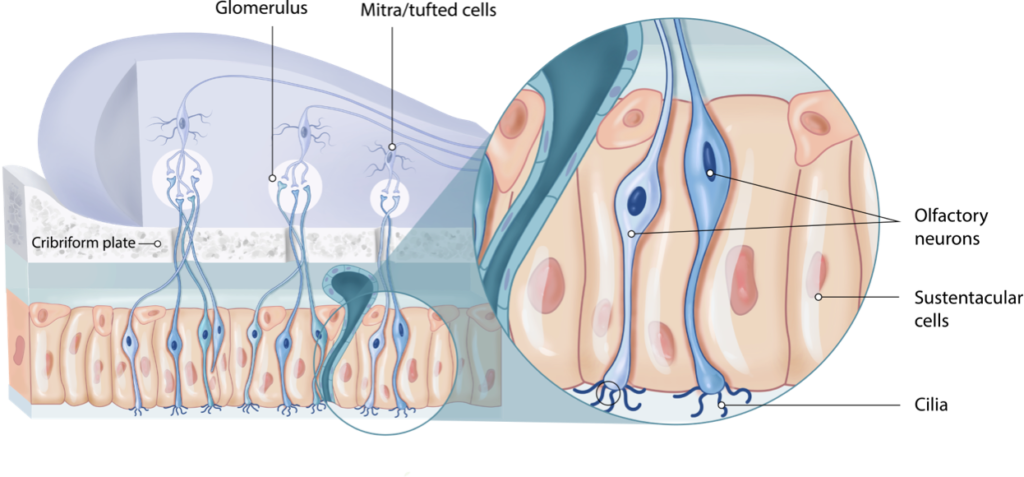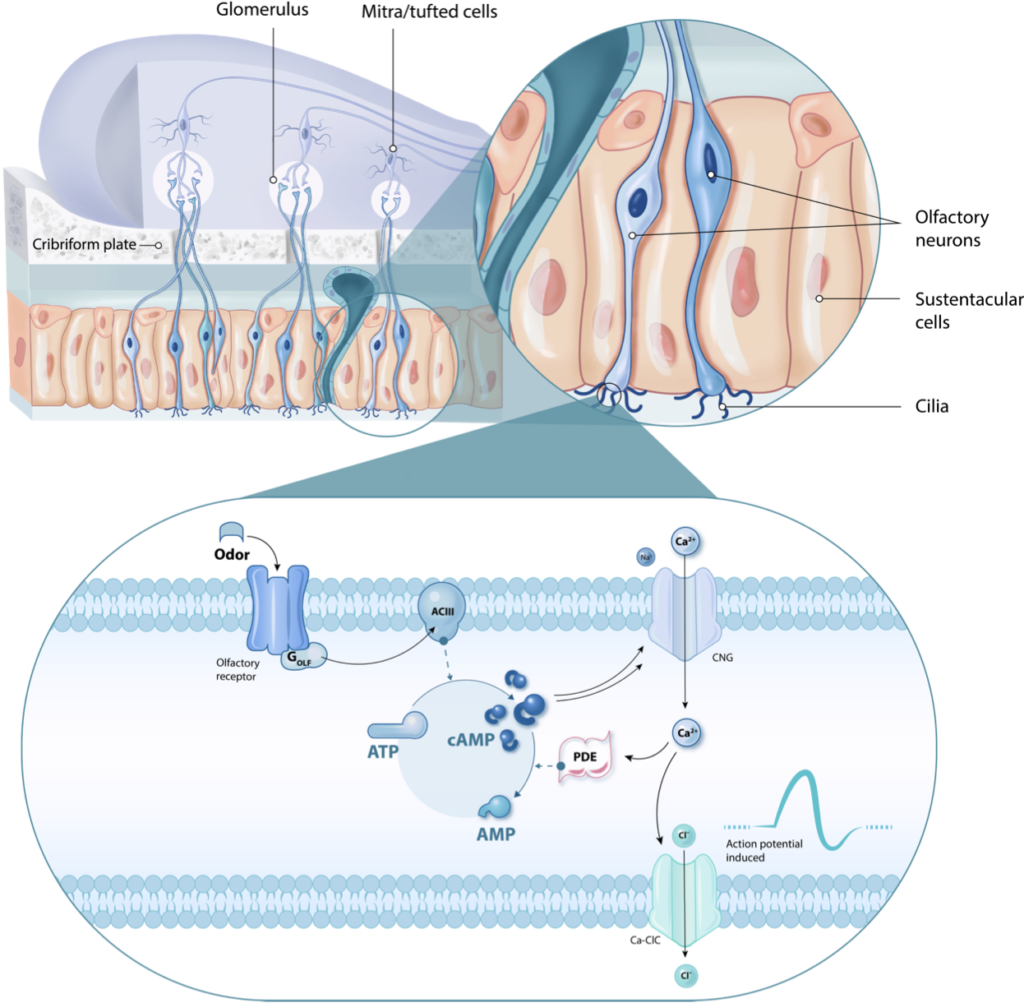Olfactory System Information
How Does the Sense of Smell Work?
Unlocking the Complexities of the Olfactory System:
How the Sense of Smell Shapes Our World
The olfactory system is one of the most intricate and fascinating sensory pathways in the human body, responsible for detecting, transmitting, and interpreting the wide array of odors we encounter daily. Beyond its role in sensory perception, the olfactory system also plays a critical part in memory, emotion, and overall quality of life. Understanding this complex mechanism not only sheds light on how we process smells but also helps diagnose and treat sensory dysfunctions that can significantly impact well-being.
Anatomy of the Olfactory System: From Molecules to Memories
The journey of a smell begins with odor molecules entering the nasal passage, where they encounter the olfactory epithelium, a specialized tissue packed with olfactory neurons. These neurons are uniquely designed to detect odor molecules through tiny hair-like structures called cilia, which extend into the nasal cavity.
Once an odor molecule binds to a receptor on the cilia, it triggers an action potential—a signal that travels through the olfactory nerves and into the olfactory bulb. The olfactory bulb serves as a processing hub, refining and organizing the information before sending it to higher brain regions like the amygdala (emotional processing), hippocampus (memory formation), and orbitofrontal cortex (perception and decision-making related to smells).
Each step of this journey is essential to the accurate perception of smells, and any disruption in the pathway can lead to sensory dysfunction, a condition that affects millions of individuals worldwide.
- Anatomical level
- Cellular Level
- Molecular level

Anatomic Level1
Odor molecules enter the nasal passage and sweep past the olfactory epithelium, where olfactory neurons reside. The odor signal is transmitted through the olfactory nerves into the olfactory bulb and is sent to the brain regions that process smell, including the amygdala, the hippocampus, and the orbitofrontal cortex.

Cellular Level1,2
Olfactory neurons in the olfactory epithelium present cilia into the nasal passage. Odor molecules bind to olfactory receptors on the cilia and trigger an action potential inside the olfactory neuron. This signal is then transmitted to synapses of tufted cells in the glomeruli in the olfactory bulb.

Molecular Level 2-5
Healthy olfactory neurons have numerous olfactory receptors coupled to G proteins.
Upon binding an odor molecule, they activate adenylate cyclase III (ACIII), which generates cyclic adenosine monophosphate (cAMP) from adenosine triphosphate (ATP).
cAMP activates cAMP-gated calcium channels (CNG), leading to calcium influx, which in turn triggers an action potential.
Calcium influx also shuts the cAMP signal down by triggering phosphodiesterase (PDE) activity, leading to cAMP degradation to adenosine monophosphate (AMP).
References: 1. Coelho DH, Reiter ER, French E, Costanzo RM. Decreasing Incidence of Chemosensory Changes by COVID-19 Variant [published online ahead of print, 2022 May 3]. Otolaryngol Head Neck Surg. 2022;1945998221097656. doi:10.1177/01945998221097656. 2. Saniasiaya J, Islam MA, Abdullah B. Prevalence and Characteristics of Taste Disorders in Cases of COVID-19: A Meta-analysis of 29,349 Patients. Otolaryngol Head Neck Surg. 2021;165(1):33-42. doi:10.1177/0194599820981018 3. Boscolo-Rizzo P, Hummel T, Hopkins C, et al. High prevalence of long-term olfactory, gustatory, and chemesthesis dysfunction in post-COVID-19 patients: a matched case-control study with one-year follow-up using a comprehensive psychophysical evaluation. Rhinology. 2021;59(6):517-527. doi:10.4193/Rhin21.249 4. Boscolo-Rizzo P, Guida F, Polesel J, et al. Self-reported smell and taste recovery in coronavirus disease 2019 patients: a one-year prospective study. Eur Arch Otorhinolaryngol. 2022;279(1):515-520. doi:10.1007/s00405-021-06839-w
The Cellular and Molecular Marvel of the Olfactory System
At the cellular level, the olfactory neurons work tirelessly to decode the chemical world around us. Embedded in the olfactory epithelium, these neurons house receptors specifically tailored to interact with odor molecules. This interaction is where the molecular magic begins.
When an odor molecule binds to its receptor, it activates a cascade of molecular events:
- G proteins associated with the receptor initiate the production of cyclic adenosine monophosphate (cAMP) from ATP.
- cAMP opens calcium-gated ion channels (CNG), allowing calcium to flood into the neuron, creating an electrical signal.
- This signal propagates through the neuron, ultimately being transmitted to glomeruli in the olfactory bulb, where it is processed further.
- To prevent overstimulation, calcium influx also triggers phosphodiesterase (PDE) activity, breaking down cAMP and restoring the system to its baseline state.
This tightly regulated process allows the olfactory system to discern a nearly infinite variety of odors with remarkable precision.
Sensory Dysfunction: The Silent Indicator of Health Issues
Disruptions in the olfactory system can occur at various levels—anatomical, cellular, or molecular. These dysfunctions can manifest as a diminished or altered sense of smell, a condition known as anosmia or hyposmia. Common causes include:
- Anatomical blockages such as nasal polyps or chronic sinus infections.
- Cellular damage due to neurodegenerative diseases like Parkinson’s or Alzheimer’s.
- Molecular malfunctions that impair the ability of neurons to transmit signals effectively.
The impact of olfactory dysfunction goes beyond the sensory experience. It can signal broader health issues and significantly diminish quality of life by affecting taste perception, emotional well-being, and safety awareness.
Why Understanding the Olfactory System Matters
Advances in research are uncovering the links between the olfactory system and overall health, highlighting its role as a potential biomarker for early detection of neurological and systemic conditions. By focusing on the molecular and cellular processes underlying smell, scientists and clinicians can develop targeted therapies to restore function and improve patient outcomes.
Whether you’re exploring the sense of smell out of curiosity or seeking solutions to sensory dysfunction, understanding the olfactory system is a step toward unlocking the full potential of human perception.

Olfactory System Health Tips
Support
Nasal Health
Regular hydration and proper nasal hygiene can maintain the health of the olfactory epithelium.
Protect
Against Toxins
Avoid exposure to pollutants and harmful chemicals that can damage olfactory neurons.
Monitor
Changes in Smell
Sudden changes in olfactory ability may indicate olfactory system issues—consult a specialist if you notice significant alterations.
Encourage
Cognitive Stimulation
Activities that engage memory and smell (e.g., cooking or gardening) can promote brain health, and help your sense of smell.